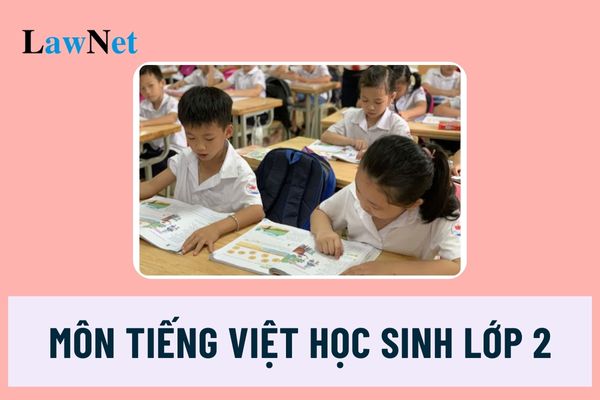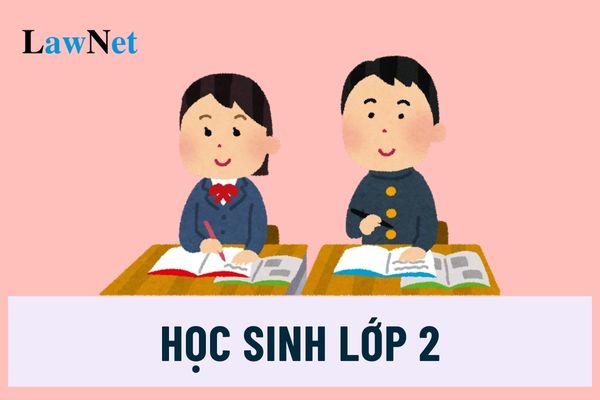Vietnam: What are the requirements and contents thereof for 2nd Graders in the education program for the Vietnamese language?
What are the requirements and contents thereof for 2nd Graders in the education program for the Vietnamese language?
Under Subsection 2, Section 5 of the Education Program for Literature promulgated together with Circular 32/2018/TT-BGDDT, specific requirements and contents thereof for 2nd Graders in the education program for the Vietnamese language are defined as follows:
| Requirements | Contents |
|
READING Reading Skills - Read correctly the words (including some difficult and rarely used words). Master the Vietnamese alphabet; know the difference between letter names (a, be, ce,...) and sounds (a, bo, co,...) that letters and characters represent. - Read clearly and correctly paragraphs, stories, poems, short information texts. Reading speed is about 60 - 70 words per minute. Know how to pause at punctuation marks and poetry rhythm. - Initially distinguish between character dialogue and narrator's speech to read with appropriate intonation. - Know how to read silently. - Recognize information on book covers: illustrations, book title, author name, publisher. - Fill in important information on the book reading card. READER COMPREHENSION Literary Texts Comprehension of Content - Know how to ask and answer questions about some details in the text, such as: Who? What? Doing what? When? Where? How? Why? - Understand what the author wants to say through simple texts based on given hints. Comprehension of Form - Recognize the places, times, and main events of the story. - Identify the appearance, gestures, actions of characters through language and images. - Recognize rhymes in poems. Connection, Comparison, Linkages - Name your favorite character and explain why. Extended Reading - During a school year, read at least 35 literary texts of types and lengths similar to the texts studied. - Memorize at least 6 poetry sections, poems, or text paragraphs studied; each section, poem, or paragraph has about 30 - 45 words. Information Texts Comprehension of Content - Know how to ask and answer questions about prominent details of the text, such as: Who? What? Doing what? When? Where? How? Why? - Based on hints, answer: What is the text about and what notable information does it contain? Comprehension of Form - Recognize some simple, common information texts through text features: book contents, student lists, timetables, schedules, texts introducing species, objects, or guides for activities. - Recognize the sequence of events, phenomena stated in the text. Connection, Comparison, Linkages - Identify useful information for oneself from the text. - Recognize basic information from the text shown through the title, illustrations, and image captions. Extended Reading During a school year, read at least 18 information texts of types and lengths similar to the texts studied. |
VIETNAMESE KNOWLEDGE 1. Vietnamese alphabet, differences between letter names (a, be, ce,...) and sounds (a, bo, co,...) 2. Themed vocabulary 3.1. Words indicating objects, activities, qualities 3.2. Uses of period, question mark, exclamation mark: indicate the end of a sentence; comma: separate parallel components in a sentence 4.1. Dialogue: listening, taking turns speaking 4.2. Paragraphs - Paragraphs retelling an event - Short, simple descriptive paragraphs based on suggestions - Paragraphs about personal feelings for loved ones - Paragraphs introducing species, objects; instructional texts for activities, postcards, lists, book contents, timetables, schedules 5. Information through images (nonverbal communication means) LITERATURE KNOWLEDGE 1. Topics (writing, storytelling about what) 2. Appearance, gestures, dialogues of characters 3. Relationships and attitudes between characters 4. Rhymes in poetry LITERATURE MATERIAL 1.1. Literary Texts - Fairy tales, fables, short stories; descriptive paragraphs - Poems, folk songs, folk rhymes, chants Text length: stories about 180 - 200 words, descriptive texts about 150 - 180 words, poems about 70 - 90 words 1.2. Information Texts - Texts introducing species, objects; instructional texts for simple activities, including signs - Student lists; book contents; timetables; schedules Text length: about 110 - 140 words 2. Suggestions for text selection: see suggestion list |
|
WRITING Writing Skills - Master regular handwriting, write capital letters correctly. - Capitalize first letters of sentences, write correct names of people, common geographical names in the city. - Dictate and write correctly poems or text paragraphs of about 50 - 55 words, with a speed of about 50 - 55 words in 15 minutes. Write correctly some words easily misspelled due to local pronunciation. - Present written texts neatly and consistently. SHORT PARAGRAPH WRITING Writing Process - Determine the content by answering the question: “What to write about?”; draft; with teacher’s support, correct punctuation, capitalization, and word usage errors. Writing Practice - Write 4 - 5 sentences recounting an event witnessed or participated in based on suggestions. - Write 4 - 5 sentences describing a familiar object based on suggestions. - Write 4 - 5 sentences about personal feelings towards a loved one or an event based on suggestions. - Write 4 - 5 sentences introducing a familiar object based on suggestions. - Name a picture. - Write timetables, postcards, messages, thank-you notes, apologies. SPEAKING AND LISTENING Speaking - Speak clearly, with the habit of looking at the listener. - Know how to speak and respond to greetings, farewells, thanks, apologies, invitations, proposals, congratulations, condolences, consolations, praises, and expressions of surprise; agree, disagree, and refuse appropriately to the listener. - Narrate a simple story (with images) that has been read, heard, or seen. - Briefly talk about a story or poem he/she has read by personal choice (text title, content, favorite character). Listening - Have the habit and attitude of paying attention when others speak. Can ask questions about unclear points when listening. - Listen to a poem or song and, based on suggestions, say a few sentences expressing personal feelings about it. - Listen to a story and, based on suggestions, give opinions on the main character or an event in the story. Interactive Speaking-Listening - Can discuss in groups about characters in a story based on suggestions. - Can discuss in groups about an issue: listen attentively to others, contribute personal opinions, do not interrupt when others are speaking. |
>> See the Education Program for Literature promulgated together with Circular 32/2018/TT-BGDDT: Download

What are the requirements and contents thereof for 2nd Graders in the education program for the Vietnamese language? (Image from the Internet)
How does the 2nd-grade education program for the Vietnamese language contribute to building the overall objectives?
Under Section 3 of the Education Program for Literature promulgated together with Circular 32/2018/TT-BGDDT, the 2nd-grade education program for the Vietnamese language contributes to building the following overall objectives:
- Forming and developing essential qualities in students: patriotism, kindness, diligence, honesty, and responsibility; nurturing the soul, shaping personality, and developing individuality.
Helping students explore themselves and the world around them, understand people, have a rich inner life, have a humanistic way of living and behavior; foster a love for the Vietnamese language and literature; develop a sense of national origin and identity, contribute to preserving and developing Vietnamese cultural values; have a willingness to receive the quintessence of human culture and an ability to integrate internationally.
- Contributing to helping students develop general competencies: self-management, self-study, communication and cooperation, problem-solving, and creativity.
Particularly, the Literature subject (Vietnamese Language) helps students develop linguistic competence and literary competence: train reading, writing, speaking, and listening skills; have a foundational general knowledge of Vietnamese and literature, develop figurative and logical thinking, contribute to forming the basic literacy of a cultured person; know how to create common texts; know how to receive and evaluate literary texts specifically, communication products, and aesthetic values in general in life.
How does the 2nd-grade education program for the Vietnamese language contribute to building primary school-level subject objectives?
Under Section 3 of the Education Program for Literature promulgated together with Circular 32/2018/TT-BGDDT, the 2nd-grade education program for the Vietnamese language contributes to building primary school-level subject objectives as follows:
- Helping students form and develop key qualities with specific expressions: love for nature, family, and hometown; a sense of origin; an appreciation for beauty and goodness with healthy emotions; an interest in learning and labor; honesty and integrity in learning and life; a sense of responsibility towards themselves, their family, society, and the surrounding environment.
- Helping students initially form general competencies, and develop language skills in all reading, writing, speaking, and listening abilities at a basic level: reading correctly and fluently; understanding the main content and information of texts; connecting and comparing outside the text; writing correctly in spelling and grammar; write several sentences, paragraphs, essays (mainly narrative and descriptive essays); speak clearly; listen and understand the speaker's opinions.
Developing literary competence with the requirement to distinguish between poetry and stories, know how to read poetry and stories; recognize the beauty of artistic language; have imagination, understand, and be moved by the beauty and goodness of humans and the surrounding world expressed in literary texts.


- What is the law on light reflection? What are details of the law on light reflection?
- What is the schedule of the AFF Cup 2024 (ASEAN Cup)? What are activities for physical education and sports in vocational education institutions in Vietnam?
- What is the schedule for the AFF Cup 2024 matches of the Vietnam National Team? Are students who are athletes in Vietnam eligible for a special exemption from high school graduation requirements?
- Vietnam: What are the guidelines for analysis of the poem "Tiến sĩ giấy"? What is the regulatory age of students entering lower secondary education?
- What is the location of Vietnam International Defense Exhibition 2024? Are students of all educational levels granted leave to visit the Vietnam International Defense Exhibition?
- What is the formula for calculating population density in Vietnam? What is the population density?
- Vietnam: What is the sample parent-teacher conference scenario at the end of the first semester of primary education? What are the regulations on the organization of parent committees?
- Vietnam: What is the sample outline for an essay on the analysis of the excerpt "The Last Leaf"? What are the assessment levels for learning results in the school year of 8th-grade students?
- What is the unit of power? When do students in Vietnam study the unit of power?
- What is the guidance for children to tell the story "Chuyện bốn mùa"? What is the age of students entering 2nd grade in Vietnam?

